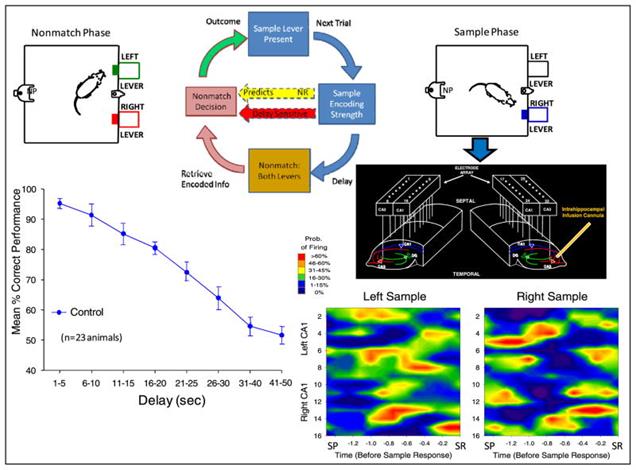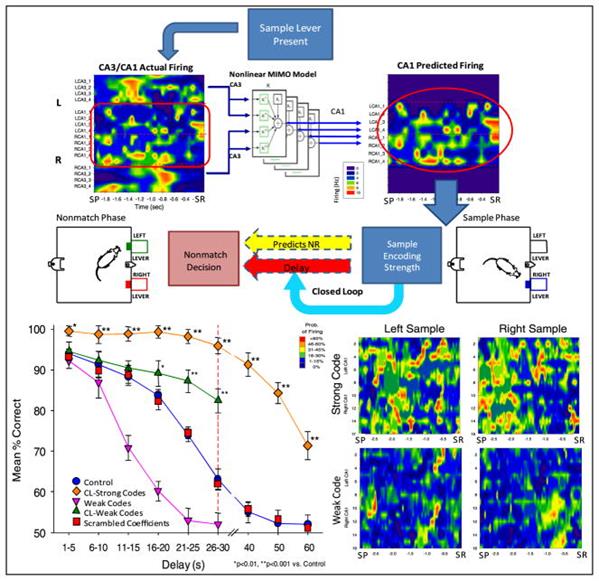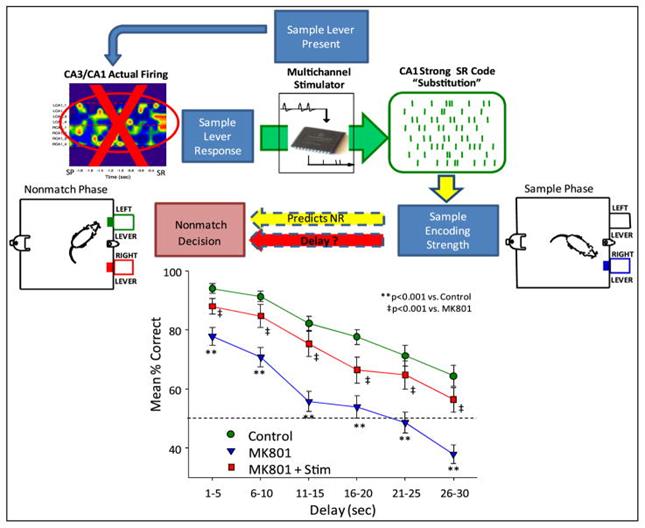Unidirectional sensors or devices with feedback that are implanted into the brain can be used to treat various diseases such as epilepsy and Alzheimer's disease, to manage limb prostheses and exoskeletons, to receive signals from the
bionic eye , and also to perform the functions of the brain itself.
Over the past thirty years, scientists have been trying to create a device that mimics the processes occurring in the hippocampus in order to restore the ability of people to create new memories — transfer data from short-term memory to long-term memory. In one of the last works, a team from several American universities improved the results of solving problems of memorization by 35-37%.
Let's discuss how far the researchers have come in this area and from whom we can expect new solutions in the future.
 Shot from the movie "Johnny Mnemonic"
Shot from the movie "Johnny Mnemonic"Brain implants are classics of science fiction, they are found in films (“Johnny Mnemonic”) and books (“Enclaves”). Often in the fantasies of writers and screenwriters, they are designed to replace and expand memory, increase learning ability and to gain access to the network. In the “Enclaves”, an additional processor could be inserted into the port in the cranial box, which would multiply the capacity of the brain.
In real life, examples of brain implants are already there. One of the first devices working inside the skull for information was a
cochlear implant to compensate for hearing loss with
neurosensory hearing loss : in this disorder, hearing is lost due to the defeat of the sound-perceiving apparatus. Neuroprosthesis transforms electrical impulses from an external microphone into signals that are understandable to the human nervous system. The technology has been used since the 1960s.
 A sourceEye prosthetics
A sourceEye prosthetics works according to a similar system: data from the camera built into the glasses is transmitted to the main device, which converts the image into a signal that comes to the electrodes attached to the retina or implanted in the brain. While all devices from this area allow us to see only the outlines of objects, we are not talking about colors.
One of the means of helping patients with epilepsy is invasive monitoring. Electrodes are implanted into patients' brains that help doctors determine the zone of onset of an epileptic seizure and its spread. Accurate determination of these parameters allows for effective surgical measures to treat the patient. Another area that should help people with Alzheimer's disease or depression, in which drugs affect the brain, are
implants for the direct introduction of medication into the brain, which the team from the Massachusetts Institute of Technology is working on.
There are experiments in the field of more rare diseases. One of the first cyborgs
Neil Harbisson since childhood does not see the flowers because of
achromatopsia . He developed a device that allows him to "hear" color.

Another promising direction is memory improvement. Scientists still do not fully understand how the human brain works, but they are already capable of restoring some of its functions — the devices literally imitate its behavior by recreating the electrical signals received by stimulating the right areas in the correct sequence.
Theodore Berger of the University of Southern California has been looking for a way to improve human memory for over 25 years with implantable brain devices. In the early 2000s, a group of scientists under his leadership created one of the first
hippocampal prostheses for experimental rodents. This area of the brain is responsible for the transition of short-term memory into long-term memory. Symptoms of the most common form of dementia — Alzheimer's disease — include short-term memory disorder, and one of the earliest signs of the disease is a decrease in this part of the brain.
In 2010, Berger conducted a series of
experiments on rats with implanted electrodes that captured the CA3 and CA1 regions of the hippocampus. Rodents solved problems while in a cell with two levers hiding in a wall. At first it was necessary to press the lever, then he cleaned into the wall for a certain time, and after the rat chose one of the two levers that appeared. To get water, the rodent had to press the opposite lever to the starter, and if he pressed the same one, the test subject was punished by turning off the light. The time for solving the problem was gradually increased from 5 to 60 seconds. Electrodes at this time recorded signals of neurons when the lever was pressed.

The recorded “code” allowed us to create a stimulation model to improve the performance of solving this problem. The graph in the lower left part of the image shows in orange the results obtained during brain stimulation using this model, and the blue - control results recorded at the previous stage of the experiment. In this case, the stimulation was carried out not at the moment of guessing the lever, but at the moment of the first interaction with it - that is, for memorization.
 Adding Artificial Signals to Theodore W. Berger, Robert E. Hampson, Dong Song, Anushka Goonawardena, Vasilis Z. Marmarelis, Sam A. Deadwyler, 2011
Adding Artificial Signals to Theodore W. Berger, Robert E. Hampson, Dong Song, Anushka Goonawardena, Vasilis Z. Marmarelis, Sam A. Deadwyler, 2011In 2011, the Berger team
demonstrated the ability to enable and disable animal memory using sensors in the rat brain. Rodents with the help of drugs blocked the ability to create long-term memories - blocked the work of the CA3 area, and then restored it with the help of electrodes. Artificial signals, recreating the activity of neurons, improved the percentage of correct answers.
 Replacing the natural hippocampal signal with an artificial one (Theodore W. Berger, Robert E. Hampson, Dong Song, Anushka Goonawardena, Vasilis Z. Marmarelis, Sam A. Deadwyler, 2011)
Replacing the natural hippocampal signal with an artificial one (Theodore W. Berger, Robert E. Hampson, Dong Song, Anushka Goonawardena, Vasilis Z. Marmarelis, Sam A. Deadwyler, 2011)In 2017, experiments began on people with electrodes implanted in the brain. Twenty volunteers solved memorization tasks. First, the implant registered neural signals, and then “helped” the person to remember the answer to the problem due to brain stimulation. Then the short-term memory was improved by 15%. A new study,
published March 28, 2018 , increased this figure to 35-37%. Since 2014, the DARPA agency is interested in the issue of memory restoration: it funded this research, and also issues research grants in the field of creating sensors with feedback that are implantable in the brain.
For a new study, a group of scientists from the Baptist Medical Center Wake Forest and the University of Southern California attracted eight patients with epilepsy to the experiment, participating in a diagnostic brain mapping procedure. Electrodes were installed in different parts of the participants' brains. The study was aimed at
episodic memory , which contains information useful for a short period of time - it is with it that the main problems arise in people with Alzheimer's disease, stroke and head injuries.
 Electrode system for monitoring and duplicating the hippocampal neural activity
Electrode system for monitoring and duplicating the hippocampal neural activityIn one of the tests, patients performed tasks on colored geometric shapes, while sensors recorded the activity of neurons in the hippocampus. After viewing a given figure, they had to choose it from four or five options. Brain stimulation in the correct sequence increased the efficiency of solving such problems by 37%. The second test was to guess the photos an hour after they were shown. This time, stimulation made it possible to improve performance by 35%.
In the upper left of the image marked “Actual" are the recorded neuron signals between areas of the hippocampus, known as CA3 and CA1. This is what the sensors tracked at the time when participants looked at the given images. Scientists analyzed the records made during the correct answers, and recreated them using feedback.
 A source
A source“We have proven that we can climb into the patient’s memory, record the signal and send it back. Even in cases where a person’s memory is weakened, neural signal patterns can be identified and the correct patterns can be separated from the wrong signals. Then we can help the brain of the patient in the formation of new memories - not to replace the memory function itself, but to enhance it. Now we are trying to determine how it is possible to improve the memory function, but in the future we hope to help people write specific memories - for example, where they live, what their grandchildren look like when their own memory stops working, ”says Robert Hampson, a physiology professor, Pharmacology and Neurology, Wake Forest Baptist Medical Center, one of the authors of the study.
Over the commercialization of technology Berger
works startup KerNEL. The company's founder, Brian Johnson, wants not only to start selling devices for memory recovery, but also to create new implants to improve the person’s attention and creative abilities, that is, in fact, to go beyond the medical use of devices. In this case, the devices have a chance to get away from the need to comply with all the requirements for medical equipment and stand on a par with fitness bracelets.
Johnson has money for the project thanks to the sale of PayPal for $ 800 million in 2013. Another person associated with this project - Ilon Mask - in 2016
registered the company Neuralink and hired people associated with brain research. In the short term, Musk wants to produce devices for the treatment of various brain diseases, but in the future, like Johnson, he wants to improve people. Including - giving them telepathic capabilities. In March 2018, it became known that the Mask company
received permission to experiment on animals in San Francisco. Neurlalink continues to search for specialists in the team -
job vacancies for engineers in the field of robotics, microelectronics, software developers and others
are posted on the site . One of the main requirements is the desire to overcome big challenges.
For the past two years, DARPA has been working on the creation of implantable neural interfaces to obtain
"unprecedented signal resolution and bandwidth for transmitting information between the human brain and electronic systems .
" There are interesting examples of elastic electrodes, such as the
device developed by scientists from Linköping University (Sweden): based on it, researchers from the University of Lund in Sweden developed a
solution that can store and process data from more than 1 million neurons in real time and provide feedback at a speed of 25 milliseconds
Further development of hardware and processing solutions will translate part of brain research into software. To increase efficiency, standardization of all elements of neurocomputer systems is necessary. But for now it is science fiction.